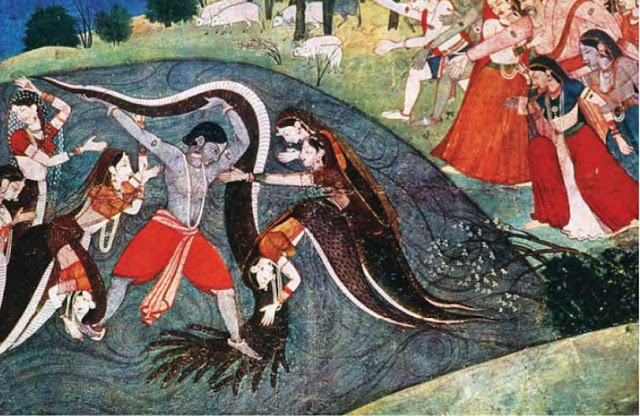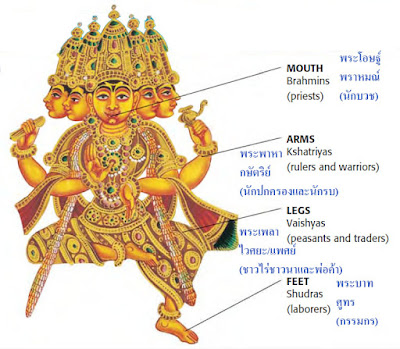Indo-Europeans Migrate/การอพยพของชาวอินโด-ยุโรเปียน
Indo-Europeans Migrate
The Indo-Europeans were a group of nomadic peoples who may have come from the steppes—dry grasslands that stretched north of the Caucasus. The Caucasus are the mountains between the Black and Caspian seas. These primarily pastoral people herded cattle, sheep, and goats. The Indo-Europeans also tamed horses and rode into battle in light, two-wheeled chariots. They lived in tribes that spoke forms of a language that we call Indo-European.
The Indo-European Language Family
The languages of the Indo-Europeans were the ancestors of many of the modern languages of Europe, Southwest Asia, and South Asia. English, Spanish, Persian, and Hindi all trace their origins back to different forms of the original Indo-European language.
Historians can tell where Indo-European tribes settled by their languages. Some Slavic speakers moved north and west. Others, who spoke early Celtic, Germanic, and Italic languages, moved west through Europe. Speakers of Greek and Persian went south. The Aryans, who spoke an early form of Sanskrit, located in India.
Notice the similarities of words within the Indo-European family of languages.
|
ชาวอินโด-ยุโรเปียนอพยพ
ชาวอินโด-ยุโรเปียนคือกลุ่มคนเร่ร่อนที่น่าจะเดินทางมาจากที่ราบกว้างใหญ่ไม่มีต้นไม้ เป็นทุ่งหญ้าที่แห้งแล้งทอดยาวเหยียดจากด้านทิศเหนือของเทือกเขาคอเคซัส เทือกเขาคอเคซัสอยู่ระหว่างทะเลดำและทะเลแคสเปียน ผู้คนส่วนใหญ่จะเป็นเกษตรกรเลี้ยงปศุสัตว์ มีการเลี้ยงวัวควาย แกะ และแพะ ชาวอินโด-ยุโรเปียนจะฝึกม้าให้เชื่องและนั่งรถสองล้อมีน้ำหนักเบาเข้าทำสงคราม อาศัยอยู่ในชนเผ่าที่พูดภาษาที่เราเรียกว่า อินโด-ยุโรเปียน
ตระกูลภาษาอินโด – ยูโรเปียน
ภาษาอินโด – ยูโรเปียนเป็นต้นตระกูลของภาษาสมัยใหม่หลายภาษา คือ ยุโรป เอเชียตะวันตกเฉียงใต้ และเอเชียใต้ ภาษาอังกฤษ ภาษาสเปน ภาษาเปอร์เซียและภาษาฮินดีล้วนมีแหล่งกำเนิดมาจากภาษาอินโด-ยุโรเปียนดั้งเดิมที่มีรูปแบบแตกต่างกัน
นักประวัติศาสตร์สามารถบอกสถานที่ที่ชนเผ่าอินโด - ยูโรเปียนตั้งถิ่นฐานอยู่ตามภาษาของพวกเขา ผู้คนที่พูดภาษาสลาฟบางพวกได้อพยพไปทางทิศเหนือและทิศตะวันตก อีกพวกหนึ่งที่พูดภาษาเซลติกดั้งเดิม ภาษาเจอร์แมนิกดั้งเดิมและภาษาอิตาลีดั้งเดิม ได้อพยพไปทางตะวันตกผ่านยุโรป ผู้คนที่พูดภาษากรีกและเปอร์เซียเดินทางไปทางทิศใต้ ชาวอารยันที่พูดภาษาสันสกฤตรูปแบบดั้งเดิมได้ตั้งรกรากในอินเดีย
ลองสังเกตความคล้ายคลึงกันของคำในภาษาตระกูลอินโด-ยุโรเปียน (ในตารางด้านซ้ายที่เป็นภาษาอังกฤษ)
ความเหมือนกันของตระกูลภาษาอังกฤษ สันสกฤต เปอร์เซีย สเปน และ เยอรมนี ทั้งหมดมีคำแปลตามลำดับดังนี้ แม่ พ่อ ลูกสาว ใหม่ หก อีกภาษาหนึ่งคือภาษาบาลี ซึ่งอยู่ในตระกูลเดียวกับภาษาสันสกฤต แต่ภาษาบาลีเป็นภาษาชาวบ้าน ภาษาสันสกฤตเป็นภาษาชาวเมือง (พระพุทธเจ้าทรงใช้ภาษาชาวบ้าน คือ ภาษาบาลีในการเผยแพร่คำสอนของพระองค์ เพราะเป็นภาษาที่ไม่สลับซับซ้อนเหมือนภาษาสันสกฤต) เทียบดังนี้ mātā (แม่) pitā (พ่อ) dītā(ลูกสาว) nava (ใหม่) cha (หก)
| ||||||||||||||||
An Unexplained Migration
No one knows why these people left their homelands in the steppes. Whatever the reason, Indo-European nomads began to migrate outward in all directions between 1700 and 1200 B.C. These migrations, movements of a people from one region to another, happened in waves over a long period of time.
The Hittite Empire
By about 2000 B.C., one group of Indo-European speakers, the Hittites, occupied Anatolia, also called Asia Minor. Anatolia is a huge peninsula in modern-day Turkey that juts out into the Black and Mediterranean seas. Anatolia is a high, rocky plateau, rich in timber and agriculture. Nearby mountains hold important mineral deposits. Separate Hittite city-states came together to form an empire there in about 1650 B.C. The city of Hattusas was its capital.
The Hittite empire went on to dominate Southwest Asia for 450 years. Hittites occupied Babylon, the chief city in the Tigris-Euphrates Valley, and struggled with Egypt for control of northern Syria. Neither the Hittites nor the Egyptians were able to get the upper hand. So, the two peoples ended their conflicts by signing a peace treaty. They each pledged to help the other fight off future invaders.
Hittites Adopt and Adapt
The Hittites used their own Indo-European language with one another. However, for international use, they adopted Akkadian, the language of the Babylonians they had conquered. The Hittites borrowed ideas about literature, art, politics, and law from the Mesopotamians. The Hittites thus blended their own traditions with those of other, more advanced peoples.
Chariots and Iron Technology
The Hittites excelled in the technology of war. They conquered an empire against Egyptian opposition—largely through their superior chariots and their iron weapons. The Hittite war chariot was light and easy to maneuver. The chariot had two wheels and a wooden frame covered with leather and was pulled by two or sometimes four horses. The Hittite chariot proved itself a superb fighting machine.
|
การอพยพที่ไม่สามารถจะบรรยายได้
ไม่มีใครทราบสาเหตุที่ผู้คนเหล่านี้อพยพออกจากบ้านเกิดเมืองนอนของตนเองในที่ราบกว้างใหญ่ซึ่งไม่มีต้นไม้ จะเป็นด้วยสาเหตุใดก็ตาม กลุ่มชนเร่ร่อนชาวอินโด-ยุโรเปียนได้เริ่มอพยพออกไปทุกทิศทางในระหว่าง 1700 – 1200 ปีก่อนคริสตกาล การอพยพเหล่านี้ เป็นการอพยพของผู้คนจากภูมิภาคหนึ่งไปยังอีกภูมิภาคหนึ่ง เกิดขึ้นเป็นระลอก ๆ ตลอดระยะเวลาอันยาวนาน
จักรวรรดิฮิตไทต์
ประมาณ 2000 ปีก่อนคริสตกาล กลุ่มคนที่พูดภาษาอินโด-ยุโรเปียนกลุ่มหนึ่ง เรียกว่า ฮิตไทต์ ได้เข้ายึดครองดินแดนอานาโตเลีย เอเชียน้อย ก็เรียก อานาโตเลีย คือคาบสมุทรขนาดมหึมาในประเทศตุรกีในปัจจุบัน ซึ่งยื่นออกไปสู่ทะเลดำและทะเลเมดิเตอร์เรเนียน อานาโตเลียเป็นที่ราบสูง เต็มไปด้วยหิน อุดมสมบูรณ์ไปด้วยป่าไม้และการเกษตร ภูเขาที่อยู่รอบ ๆ มีสินแร่มากมาย นครรัฐของชาวฮิตไทต์ที่เป็นเอกเทศได้มารวมกันก่อตั้งจักรวรรดิในที่นี้เมื่อประมาณ 1650 ปีก่อนคริสกาล มีเมืองหลวงชื่อ ฮัตทูซา
จักรวรรดิฮิตไทต์ได้เดินหน้าแผ่อิทธิพลไปเอเชียตะวันตกเฉียงใต้ เป็นเวลา 450 ปี ชาวฮิตไทต์ยึดครองบาบิโลน ซึ่งเป็นเมืองสำคัญในลุ่มแม่น้ำไทกริส-ยูเฟรติส และแข่งขันกันกับอียิปต์เพื่อยึดครองซีเรียตอนเหนือ ทั้งฮิตไทต์และอียิปต์ต่างก็ไม่สามารถยึดความได้เปรียบ ดังนั้น ทั้งสองพวกจึงยุติการขัดแย้งกันด้วยการลงนามสนธิสัญญาสันติภาพ ทั้งสองฝ่ายให้คำมั่นสัญญาว่าจะช่วยเหลือกันขับไล่เหล่าผู้รุกรานในอนาคต
ชาวฮิตไทต์ยอมรับและปรับตัว
ชาวฮิตไทต์ใช้ภาษาอินโด-ยุโรเปียนของตนเองในการพูดจาต่อกัน แต่อย่างไรก็ตาม สำหรับการใช้ระดับนานาชาติ พวกเขายอมรับเอาภาษาอัคคาเดียน ซึ่งเป็นภาษาของชาวบาบิโลเนียนที่ตนเองพิชิตได้ ชาวฮิตไทต์ได้ยืมแนวความคิดเกี่ยวกับวรรณคดี ศิลปะ การเมือง และกฎหมายมาจากชาวเมโสโปเตเมีย ดังนั้น ชาวฮิตไทต์จึงผสมผสานประเพณีของตนเข้ากับประเพณีของชนกลุ่มอื่นที่มีความก้าวหน้ามากกว่า
เทคโนโลยีด้านรถม้าและด้านเหล็ก
ชาวฮิตไทต์มีความเป็นเลิศในด้านเทคโนโลยีสงคราม พวกเขาพิชิตจักรวรรดิที่เป็นศัตรูของอียิปต์ ด้วยรถม้าชั้นเลิศและอาวุธเหล็ก รถม้าสงครามของชาวฮิตไทต์เบาและยักย้ายได้ง่าย รถม้านั้นมีสองล้อและมีโครงทำด้วยไม้หุ้มด้วยหนังสัตว์และลากด้วยม้าสองตัวหรือบางครั้งก็สี่ตัว รถม้าของชาวฮิตไทต์พิสูจน์แล้วว่าเป็นอุปกรณ์ในการต่อสู้ที่ยอดเยี่ยม
|
 | ||
|
The Hittites used iron in their chariots, and they owed many of their military victories to the skill of their ironworkers. Ancient peoples had long known that iron was stronger than bronze. They also knew that it could hold a sharper edge. However, the process of purifying iron ore and working it into weapons and tools is complex. Around 1500 B.C., the Hittites were the first in Southwest Asia to work with iron and harden it into weapons of war. The raw materials they needed—iron ore and wood to make charcoal—were easily available to them in the mountains of Anatolia. Knowledge of iron technology traveled widely with the Hittites—in both their trade and conquests.
Despite its military might, the powerful Hittite empire fell quite suddenly around the year 1190 B.C. As part of a great wave of invasions, tribes attacked from the north and burned the Hittite capital city.
|
ชาวฮิตไทต์ใช้เหล็กทำเป็นรถม้า และพวกเขาเป็นหนี้ด้านทักษะของช่างเหล็กในชัยชนะทางด้านทหารมากมาย ผู้คนสมัยโบราณมีความรู้ว่าเหล็กแข็งแกร่งกว่าทองสัมฤทธิ์มานานแล้ว และยังมีความรู้อีกว่าเหล็กมีสันที่คมกว่าด้วย แต่อย่างไรก็ตาม ขบวนการในการทำเหล็กให้บริสุทธิ์และทำเหล็กให้เป็นอาวุธตลอดจนเครื่องมือยังมีความสลับซับซ้อน ประมาณ 1500 ปีก่อนคริสตกาล ชาวฮิตไทต์เป็นพวกแรกในเอเชียตะวันตกเฉียงใต้ที่ทำงานด้วยเหล็กและทำเหล็กให้เป็นอาวุธใช้ในสงคราม วัตถุดิบที่พวกเขาต้องการ คือ แร่เหล็กและไม้สำหรับทำถ่าน ก็หาได้ง่ายสำหรับพวกเขาในเทือกเขาอานาโตเลีย ความรู้เรื่องเทคโนโลยีด้านเหล็กเดินทางแพร่หลายไปกับชาวฮิตไทต์ ทั้งด้านการค้าขายและด้านสงคราม
แม้ว่าจะมีความสามารถทางด้านทหาร แต่จักรวรรดิฮิตไทต์อันทรงอำนาจก็ล่มสลายอย่างฉับพลันเมื่อประมาณ 1190 ปีก่อนคริสตกาล เนื่องจากชนเผ่าที่เป็นส่วนหนึ่งของเหล่าผู้รุกกรานลูกใหญ่ได้โจมตีตั้งแต่ด้านทิศเหนือและเผาเมืองหลวงของชาวฮิตไทต์
|
Aryans Transform India
Before 2000 B.C., the Hittites began establishing themselves in Anatolia. At the same time, some scholars believe, another Indo-European people, the Aryans, whose homeland was probably somewhere between the Caspian and Aral seas, crossed over the northwest mountain passes into the Indus River Valley of India. Other scholars believe the Aryans originated in India. There is no archaeological evidence to prove either hypothesis.
Though they left almost no archaeological record, their sacred literature, the Vedas, left a picture of Aryan life. The Vedas are four collections of prayers, magical spells, and instructions for performing rituals. The most important of the collections is the Rig Veda. The Rig Veda contains 1,028 hymns to Aryan gods. For many years, no written form of the Vedas existed. Instead, elders of one generation passed on this tradition orally to the next generation.
A Caste System Develops
The Aryans fought their enemies, a people they calleddasas. The Aryans differed from the dasas in many ways. Aryans were taller, lighter in skin color, and spoke a different language. Unlike the earlier inhabitants of the Indus Valley, the Aryans had not developed a writing system. They were also a pastoral people and counted their wealth in cows. The dasas, on the other hand, were town dwellers who lived in communities protected by walls.
Aryans were organized into four groups based on occupation: 1) Brahmins (priests), 2) warriors, 3) traders and landowners, and 4) peasants or traders. The group that an Aryan belonged to determined his or her role in society.
As the Aryans settled in India, they developed closer contacts with non-Aryans. To regulate those contacts, the Aryans made class restrictions more rigid. Shudras were laborers who did work that Aryans did not want to do. Varna, or skin color, was a distinguishing feature of this system. So the four major groups came to be known as the varnas. Later, in the 15th century A.D., explorers from Portugal encountered this social system and called these groups castes (kasts).
| ชาวอารยันปฏิรูปอินเดีย
ก่อน 2000 ปีก่อนคริสตกาล ชาวฮิตไทต์เริ่มสถานปนาตนเองขึ้นในแคว้นอานาโตเลีย ในขณะเดียวกันนักวิชาการบางคนเชื่อว่า ชาวอินโด – ยูโรเปียนอีกพวกหนึ่ง คือ ชาวอารยัน ซึ่งน่าจะมีถิ่นกำเนิดอยู่ที่ไหนสักแห่งระหว่างทะเลแคสเปียนและทะเลอารัล ได้เดินทางข้ามภูเขาทางตะวันตกเฉียงเหนือผ่านเข้าไปสู่ลุ่มแม่น้ำสินธุของอินเดีย นักวิชาการอื่น ๆ เชื่อว่า ชาวอารยัน มีถิ่นกำเนิดอยู่ในอินเดีย ไม่มีหลักฐานทางโบราณคดีที่จะพิสูจน์สมมติฐานนี้แต่อย่างใด
แม้ว่าพวกเขาเกือบจะไม่ทิ้งหลักฐานทางโบราณคดี แต่วรรณคดีอันศักดิ์สิทธิ์ของพวกเขา คือ พระเวท ก็ได้ทิ้งภาพชีวิตของชาวอารยันไว้ พระเวท คือตำรารวบรวมบทสวดสรรเสริญ เวทมนตร์คาถาและคำแนะนำในการทำพิธีกรรม 4 ชุด ตำราที่สำคัญที่สุด คือ ฤคเวท ฤคเวทบรรจุบทสวดสรรเสริญเทพเจ้าของชาวอารยัน จำนวน 1,028 บท หลายปีที่ผ่านมาไม่มีแบบพระเวทที่เขียนขึ้นเป็นลายลักษณ์หลงเหลืออยู่ คนเก่าแก่รุ่นหนึ่งจะถ่ายทอดธรรมเนียมนี้ให้แก่คนรุ่นต่อไปด้วยการให้ท่องจำ
วิวัฒนาการระบบวรรณะ
ชาวอารยันได้ต่อสู้กับผู้คนที่เป็นศัตรูของตนเองที่พวกเขาเรียกว่า ทาส ชาวอารยันแตกต่างจากพวกทาสหลายแนวทาง คือ สูงกว่า สีผิวขาวกว่า และพูดภาษาแตกต่างกัน ชาวอารยันไม่เหมือนกับเหล่าผู้ตั้งหลักแหล่งในลุ่มแม่น้ำสินธุในยุคแรก คือ ไม่มีการพัฒนาระบบการเขียน ทั้งยังเป็นผู้เลี้ยงปศุสัตว์ในทุ่งหญ้าและตีค่าความมั่งมีด้วยวัวเท่านั้น ในทางตรงกันข้าม พวกทาสจะเป็นคนอาศัยอยู่ในเมืองใช้ชีวิตเป็นชุมชนมีกำแพงป้องกัน
ชาวอารยันแบ่งออกเป็น 4 กลุ่มตามพื้นฐานอาชีพ คือ 1) พราหมณ์ (นักบวช) 2) นักรบ 3) พ่อค้าและเจ้าของที่ดิน และ 4) ชาวไร่ชาวนาหรือพ่อค้า กลุ่มที่ชาวอารยันสังกัดอยู่จะจำกัดบทบาทสมาชิกในสังคม
เนื่องจากชาวอารยันได้ตั้งรกรากอยู่ในอินเดีย จึงมีวิวัฒนาการด้านความสัมพันธ์อย่างใกล้ชิดกับเหล่าผู้คนที่ไม่ใช่อารยัน โดยการจำกัดระบบวรรณะให้เข้มงวดมากขึ้น พวกศูทร คือ ชนชั้นกรรมกรผู้ทำงานที่พวกอารยันไม่ต้องการทำ วรรณะ หรือ สีผิว คือ ลักษณะที่ทำให้แตกต่างกันของระบบนี้ ดังนั้น กลุ่มหลัก ๆ 4 กลุ่ม จึงเรียกกันว่า วรรณะ ต่อมา ในคริสต์ศตวรรษที่ 15 เหล่านักสำรวจที่เดินทางมาจากประเทศโปรตุเกสได้สำรวจพบระบบทางสังคมนี้และเรียกกลุ่มเหล่านี้ว่า คาสท์ (castes ออกเสียงตามภาษาอังกฤษว่า แคซท)
|
As time went on, the four basic castes gradually grew more complex—with hundreds of subdivisions. Classical texts state that caste should not be determined by birth. However, over time, some communities developed a system in which people were born into their caste. Their caste membership determined the work they did, whom they could marry, and the people with whom they could eat. Cleanliness and purity became all-important. Those considered the most impure because of their work (butchers, gravediggers, collectors of trash) lived outside the caste structure. They were known as “untouchables,” since even their touch endangered the ritual purity of others.
Aryan Kingdoms Arise
Over the next few centuries, Aryans extended their settlements east, along the Ganges and Yamuna river valleys. Progress was slow because of difficulties clearing the jungle for farming. This task grew easier when iron came into use in India about 1000 B.C.
When the Aryans first arrived in India, chiefs were elected by the entire tribe. Around 1000 B.C., however, minor kings who wanted to set up territorial kingdoms arose among the Aryans. They struggled with one another for land and power. Out of this strife emerged a major kingdom: Magadha. Under a series of ambitious kings, Magadha began expanding in the sixth century B.C. by taking over surrounding kingdoms. By the second century B.C., Magadha had expanded south to occupy almost all of the Indian subcontinent.
One of the great epics of India, the Mahabharata, reflects the struggles that took place in India as the Aryan kings worked to control Indian lands. One part of the Mahabharata is the Bhagavad Gita. It tells the story of a warrior prince about to go to war. His chariot driver is Krishna, a god in human form.
|
เมื่อเวลาผ่านไป ระบบวรรณะพื้นฐาน 4 กลุ่ม ก็ค่อย ๆ วิวัฒนาการสลับซับซ้อนมากขึ้น มีหลายร้อยกลุ่มย่อย คัมภีร์คลาสสิกกลว่าวไว้ว่า วรรณะไม่ควรจะจำกัดด้วยชาติกำเนิด แต่อย่างไรก็ตาม เมื่อเวลาผ่านไป สังคมบางสังคมก็มีการพัฒนาระบบซึ่งประชาชนเกิดมาในวรรณะของพวกเขา สมาชิกในวรรณะของพวกได้จำกัดการงานที่พวกเขาทำ ผู้คนที่พวกเขาจะแต่งงานด้วย และผู้คนที่พวกเขาจะร่วมรับประทานอาหารได้ ความสะอาดและความบริสุทธิ์จึงกลายเป็นสิ่งที่สำคัญกว่าสิ่งอื่นทั้งหมด ผู้ที่ถือว่าไม่บริสุทธิ์มากที่สุดอันเนื่องมาจากการงานของพวกเขา (คนฆ่าสัตว์ขาย คนขุดหลุมฝังศพ (สัปเหร่อ) คนเก็บขยะ) จะอาศัยอยู่นอกโครงสร้างวรรณะ
กำเนิดราชอาณาจักรของพวกอารยัน
ผ่านสองสามศตวรรษต่อมา ชาวอารยันได้ขยายการตั้งหลักแหล่งไปทางตะวันออก ตามลุ่มแม่น้ำคงคาและยมุนา ขบวนการเป็นไปอย่างช้า ๆ เนื่องจากความยากลำบากในการถางป่าเพื่อทำการเกษตร เรื่องที่ยากลำบากนี้ดำเนินไปได้ง่ายขึ้นเมื่อมีการนำเหล็กมาใช้ในอินเดียเมื่อประมาณ 1000 ปีก่อนคริสตกาล
เมื่อชาวอารยันเดินทางมาถึงอินเดียครั้งแรก ชาวเผ่าทุกคนได้เลือกผู้นำ แต่อย่างไรก็ตาม เมื่อประมาณ 1000 ปีก่อนคริสตกาล เหล่ากษัตริย์ผู้เยาว์วัยผู้ต้องการจะตั้งเขตราชอาณาจักรขึ้น ได้กำเนิดขึ้นในหมู่ชาวอารยัน กษัตริย์เหล่านั้นได้ต่อสู้กันเพื่อแย่งดินแดนและอำนาจ การต่อสู้แย่งดินแดนและอำนาจนี้เกิดขึ้นในราชอาณาจักรสำคัญ คือ แคว้นมคธ ภายใต้การนำของกษัตริย์ผู้มักใหญ่ใฝ่สูงมาเป็นลำดับ แคว้นมคธ เริ่มจะขยายดินแดนออกไปในศตวรรษที่ 6 ก่อนคริสตกาล ด้วยการเข้ายึดราชอาณาจักรที่อยู่รอบ ๆ ประมารศตวรรษที่ 2 ก่อนคริสตกาล แคว้นมคธได้ขยายดินแดนลงมาทางใต้ยึดครองอนุทวีปอินเดียวเกือบทั้งหมด
มหากาพย์ของอินเดียชิ้นหนึ่ง คือ มหาภารตะ สะท้อนถึงการต่อสู้ดิ้นรนที่เกิดขึ้นในอินเดีย ในขณะที่กษัตริย์อารยันออกแรงเข้าควบคุมแผ่นดินอินเดีย ส่วนหนึ่งของมหากาพย์ภารตะ คือ ภควัทคีตา เล่าถึงเรื่องราวของกษัตริย์นักรบที่เข้าสู่สงคราม สารถีของพระองค์ คือ พระกฤษณะ ซึ่งเป็นเทพเจ้าที่มาในร่างของมนุษย์
|
 | ||
|
The Aryan Caste
System
The four major castes
emerged from Purusha (the first human being) shown at the picture. Purusha is
identified with the creator god Brahma. The Brahmins (priests) were his
mouth, the warriors were his arms, the landowners and traders were is legs,
and the laborers and peasants were his feet.
ระบบวรรณะของชาวอารยัน
วรรณะหลัก
4 เหล่า กำเนิดจากปุรุษะ (มนุษย์คนแรก) ดังรูปภาพ ปุรุษะ
มีความเห็นกันว่าเป็นพรหม ซึ่งเป็นเทพเจ้าผู้สร้าง พราหมณ์ (นักบวช)
เกิดจากปากของพระองค์ นักรบเกิดขาพาหา (แขน)
เจ้าของที่ดินและพ่อค้าเกิดจากพระเพลา และกรรมกรและชาวไร่ชาวนาเกิดจากพระบาทของพระองค์
|


